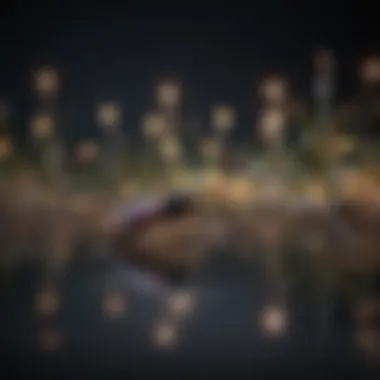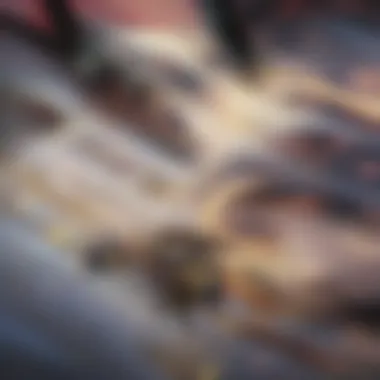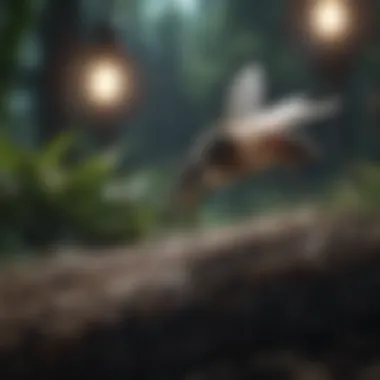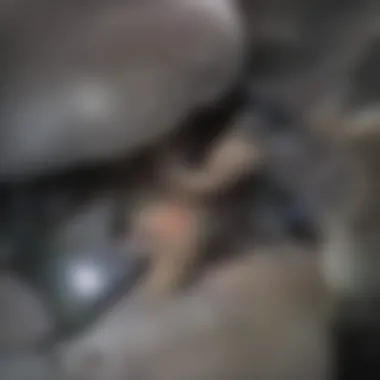Efficacy of LED Lights in Mosquito Control Strategies


Intro
Mosquitoes are more than just a nuisance. They are vectors of diseases such as malaria, dengue fever, and Zika virus. Given their significant impact on public health, effective control strategies are crucial. Traditional methods, such as chemical insecticides, have faced scrutiny due to their environmental effects and potential harm to human health. Consequently, researchers are exploring alternative methods, one of which is the application of LED technology. This examination focuses on the effectiveness of LED lights in mosquito control, particularly how different wavelengths can influence mosquito behavior.
Research Background
Overview of the Scientific Problem Addressed
The increasing resistance of mosquitoes to conventional pesticides has necessitated the exploration of innovative approaches for mosquito control. Researchers have turned their attention to the biological responses of these insects to various light wavelengths. Understanding how different light colors influence behavior is key to developing new mosquito traps and repellent mechanisms that may be both effective and environmentally friendly.
Historical Context and Previous Studies
Historically, the use of lighting to control mosquito populations is not entirely new. Earlier studies have indicated that certain wavelengths of light attract or repel mosquitoes. For instance, ultraviolet (UV) light has been shown to lure mosquitoes, making it a viable candidate for use in traps. However, the introduction of LED lights has brought new possibilities due to their energy efficiency, longevity, and capacity to emit specific wavelengths. Several studies have evaluated the effectiveness of LED lights compared to traditional bulbs, leading to a shift in perspective on how lighting can aid in vector control.
Findings and Discussion
Key Results of the Research
Research findings indicate that specific LED light wavelengths can significantly influence mosquito attraction and repulsion. For example, studies have shown that blue and green wavelengths tend to attract various mosquito species more than others. Conversely, certain red and yellow wavelengths may serve to repel them. These insights are instrumental for designing LED-based traps, enhancing their ability to target and reduce mosquito populations.
Interpretation of the Findings
The implications of these findings are wide-reaching. By integrating LED lights into existing mosquito control measures like traps and repellents, there is a potential for improved efficiency. Moreover, utilizing LED technology can reduce reliance on chemical methods, aligning with public health efforts to minimize environmental impact. However, challenges remain, such as the need for further research on the long-term efficacy and potential unintended effects of using LEDs in diverse ecosystems. These considerations highlight the complexity of mosquito control and demonstrate the necessity for an integrative approach.
"The potential for LED lights to revolutionize mosquito control strategies is significant, but it requires careful evaluation and implementation in various contexts."
Intro to Mosquitoes and Lighting Technology
Understanding the relationship between mosquito biology and lighting technology is crucial for effective mosquito control strategies. Mosquitoes are vectors for various diseases, thus, managing their populations is imperative for public health. The advent of LED technology provides innovative solutions for attracting, trapping, and even repelling these insects.
Understanding Mosquito Behavior
Mosquito behavior largely revolves around their need for survival and reproduction. These insects are attracted to specific environmental cues like light, heat, and carbon dioxide.
- Phototactic Responses:
- Chemical Signals:
- Most mosquitoes exhibit positive phototaxis, meaning they are naturally drawn to light sources, especially during twilight and nighttime.
- This behavior can be utilized to design traps that use light to lure mosquitoes.
- Additionally, mosquitoes use chemical cues from humans and other animals to locate hosts. This combination of light attraction and scent detection plays a pivotal role in their behavior.
Understanding these factors allows for the enhancement of mosquito control device efficacy. By focusing on LEDs' wavelengths, we can optimize attraction and trapping methods.
Overview of LED Technology
LED technology has revolutionized various domains, including pest control. LEDs are energy-efficient, have a long lifespan, and offer versatility in applications.
- Types of LEDs:
- Energy Efficiency:
- Integration with Technology:


- Different color LEDs emit various wavelengths, affecting the attraction levels of mosquitoes. For instance, light in the blue and ultraviolet spectrum has shown greater efficacy in drawing mosquitoes compared to standard incandescent lights.
- Using LEDs is more environmentally friendly than traditional light sources. They consume less energy, which translates to lower operational costs and a reduced carbon footprint.
- Modern designs incorporate LEDs into traps, making them more effective and user-friendly. Automated systems can now monitor mosquito populations in real-time and adapt their measures based on active mosquito flight hours.
Biological Responses of Mosquitoes to Light
The study of biological responses of mosquitoes to light is crucial in understanding how LED technology can be employed for mosquito control. These insects exhibit particular behaviors influenced by different light sources. Understanding these responses is essential because it allows us to implement effective mosquito control strategies that not only target these pests but also minimize harm to beneficial insects.
Phototaxis in Mosquito Behavior
Phototaxis refers to the movement of organisms in response to light. Mosquitoes typically exhibit positive phototaxis, which means they are attracted to light. Research indicates that this attraction is significant for both adult mosquitoes and larvae. Adult female mosquitoes, often seeking resting spots, can be drawn to artificial light sources when searching for suitable environments to lay eggs.
Understanding the mechanisms governing phototactic behavior can enhance trap designs. Traps that utilize LED lights in specific wavelengths may harness this behavior to more effectively attract mosquitoes than traditional light sources. Moreover, studies show that factors like intensity, color, and duration of light can alter how mosquitoes respond. For example, specific LED colors may attract certain mosquito species more than others, allowing targeted control strategies.
Light Wavelengths and Attraction
Light wavelengths play a pivotal role in how mosquitoes perceive and are attracted to light. Studies have shown that different wavelengths can elicit varying degrees of attraction. For instance, UV light is known to be particularly effective in drawing mosquitoes closer.
- Short wavelengths (UV light): Known to attract mosquitoes and is often used in commercial traps designed to lure these insects.
- Blue light: This wavelength has also been shown to produce significant attraction. Some traps combine both UV and blue light for enhanced effectiveness.
- Green and yellow wavelengths: Lesser attractive to mosquitoes but may still play a role in broader mosquito behavior.
Using this knowledge, researchers can further innovate LED traps tailored for particular mosquito species or regions. Such advancements can contribute significantly to developing integrated pest management strategies. By optimizing light parameters, it may become possible to create traps that are not only efficient but also eco-friendly.
"Understanding the attractant properties of light across different wavelengths paves the way for a more effective mosquito control strategy, helping to mitigate the impact of these pests on public health."
In summary, the biological responses of mosquitoes in relation to light provide essential insights into their behavior. Understanding phototaxis and the significance of different light wavelengths informs the design of more effective LED-based mosquito control systems. This knowledge not only contributes towards species-targeted traps but can also provide a sustainable, environmentally-friendly approach to mosquito management.
Integration of LED Technology in Mosquito Control
The integration of LED technology in mosquito control holds significant promise. This approach is emerging as a critical strategy in the ongoing fight against these disease-carrying insects. With the increase in mosquito-borne illnesses, the public health implications are substantial. Exploring how LEDs can be effectively utilized may lead to both improved pest management and reduced reliance on chemical insecticides.
LED lights offer various advantages that contribute to their efficacy in mosquito control. One of the primary benefits is their energy efficiency compared to traditional lighting options. This characteristic not only reduces the overall operational costs but also minimizes the environmental footprint associated with conventional light sources. Furthermore, LED technology is versatile, being usable in various commercial and residential settings, thus adapting to different ecological contexts.
LED-equipped Mosquito Traps
LED-equipped mosquito traps represent a major advancement in pest control technology. These traps use specific wavelengths of light to attract mosquitoes. Research indicates that certain wavelengths, particularly in the ultraviolet spectrum, are particularly enticing to these insects. By integrating LEDs, traps become more efficient and capable of drawing in a larger number of mosquitoes compared to conventional traps, which typically rely only on carbon dioxide or heat for attraction.
The design of these traps varies. Some are simplistic, merely using brightly colored lights to lure mosquitoes, while others incorporate more complex systems that combine light, heat, and other chemical attractants. This multi-faceted approach can enhance trapping rates significantly. In field trials, LED traps have shown promise not only in capturing mosquitoes but also in reducing their populations over time.
Repellent Applications of LED Lights
Repellent applications of LED lights offer a novel dimension in mosquito control strategies. Emerging studies suggest that certain light frequencies may not only attract mosquitoes but also effectively deter them. This dual capability makes LED technology particularly appealing. By utilizing lights that mosquitoes find unpleasant, it is possible to create non-invasive deterrent measures.
Consider the concept of light-based repellents. These systems work by employing specific LED patterns or colors that disrupt the insect's navigation abilities or make certain areas less appealing. For instance, integrating a blue light with a specific intensity may create an environment that inhibits mosquito landings. Therefore, implementing such solutions can complement traditional methods and expand the toolkit available to pest managers.
"The efficacy of LED technology in mosquito control not only relies on its ability to trap but also to repel these insects, showcasing its dual potential in integrated pest management."
In summary, the integration of LED technology in mosquito control signifies a transformative approach to dealing with these pests. The potential applications, from traps to deterrents, provide avenues for healthier environments while promoting sustainable practices. Continued research will reveal the full scope of benefits associated with utilizing LEDs in this context.


Effectiveness of LED Lights in Reducing Mosquito Populations
The effectiveness of LED lights in reducing mosquito populations is a crucial aspect of understanding modern pest control strategies. With the increasing prevalence of mosquito-borne diseases, innovative solutions such as LED technology provide new hope. This section will explore how LED lights can influence mosquito behavior, their potential integration in pest control devices, and the implications for public health.
Mosquito populations pose significant challenges to public health worldwide. Diseases like malaria, dengue fever, and Zika virus continue to affect millions of people. Consequently, the need for effective mosquito control methods has never been more apparent. Rapid innovations in technology, particularly in lighting, has led to an interest in examining LED lights as a viable option for reducing these populations.
The relevance of LED lights extends beyond mere repellence; they can also attract and trap mosquitoes more effectively than traditional approaches. The specific wavelengths emitted by LED lights may lure mosquitoes toward traps while simultaneously minimizing their presence in residential areas, thus potentially reducing disease transmission. Furthermore, LEDs can be designed to use less energy, culminating in lower operational costs associated with mosquito control.
"Novel approaches, such as LED technology, not only target mosquitoes but also consider ecological implications, promoting sustainable methods in pest control."
This section will delve into two primary areas: experimental studies and field trials. By exploring these elements, we can better understand the practical applications of LED technology in controlling mosquito populations.
Experimental Studies and Findings
Numerous experimental studies have investigated the impact of LED lights on mosquito behavior. These studies generally focus on two significant outcomes: attraction and repellent properties. Research, such as a study published in the Journal of Medical Entomology, shows that mosquitoes demonstrate stronger attraction to specific wavelengths of light, particularly in the ultraviolet and blue spectrum.
Key findings from these studies include:
- Attraction Rates: Mosquitoes frequently show a tendency to gravitate towards lights in the blue wavelength range. This can be attributed to their visual sensory preferences, suggesting that specific LED arrangements could enhance trap efficacy.
- Duration of Exposure: Duration of exposure to light also plays a role; prolonged exposure may condition some species to associate LEDs with breeding or feeding sites, creating further effectiveness in trapping scenarios.
- Behavioral Patterns: Mosquitoes exhibit phototaxis, where they move toward light sources. Studies often measure how LED wavelengths influence this behavior, revealing that particular colors can be more irresistable than others.
Such findings lay the groundwork for more targeted applications in mosquito control, providing essential data for developing efficient traps and reducing overall populations.
Field Trials of LED-based Solutions
Field trials offer a crucial lens through which the practical efficacy of LED-based solutions can be assessed. These trials are typically set up in environments where mosquito populations are well-documented, allowing researchers to observe and measure the effectiveness of LED lighting over extended periods.
Two significant considerations emerge from field trials:
- Population Reduction: Initial results have shown that areas with strategically placed LED traps can reduce mosquito populations significantly. For example, one study indicated a reduction of up to 70% in trapped adult mosquitoes, demonstrating the potential for LEDs to aid in integrated pest management.
- Comparative Analysis: Some trials compare traditional pest control measures with LED-based methods. In many cases, trials favor the LED-equipped traps due to their higher catch rates and minimal environmental impact. The sustainability factor is also a consideration, as LEDs consume less energy and are longer-lasting than conventional lights.
In summary, ongoing experimental studies and field trials are essential in establishing the effectiveness of LED lights in mosquito control initiatives. Their ability to attract, trap, and potentially repel mosquitoes opens new avenues for pest management solutions.
Environmental Impacts of Using LED Lights for Mosquito Control
The environmental implications of employing LED lights in mosquito control are crucial to any discussion surrounding their use. Mosquitoes, as vectors for various diseases, need effective management strategies, but these strategies should not come at the expense of ecological balance. LED technology, while promising, brings a set of ecological considerations that must be thoroughly examined.
This section aims to unpack the potential repercussions of LED light usage on ecosystems and establish their viability in sustainable mosquito management practices.
Assessing Ecological Effects
When considering the use of LED lights for mosquito control, one must assess their broader ecological effects. The interaction between light and insect behaviors can trigger changes in local biodiversity, affecting not just mosquitoes but other insects as well. For example, some studies indicate that certain LED wavelengths can attract non-target insects, which might consequently disturb local ecosystems.
- Non-target Species: The impact on beneficial species such as pollinators must be taken into consideration.
- Altered Predator-Prey Relationships: Changing insect behaviors due to artificial light can also disrupt predator-prey dynamics.
- Habitat Light Pollution: Excessive light exposure may alter natural habitats, leading to unforeseen consequences like disorientation or altered reproduction rates.
Stakeholders must analyze these factors when implementing LED technology as a mosquito control solution. Field studies are necessary to gather evidence and refine practical applications.
Energy Efficiency and Sustainability
Energy efficiency is a pillar of LED technology, making it appealing for long-term mosquito control strategies. LEDs consume significantly less energy than traditional lighting methods. This aspect can lead to reduced carbon footprints and lower operational costs.


However, energy efficiency also raises questions about sustainability in mosquito management:
- Life Cycle Assessment: The entire life cycle of LED bulbs—from production to disposal—should be evaluated for environmental impact.
- Renewable Energy Sources: Leveraging renewable energy to power LEDs can further enhance their sustainability profile.
- Long-Lasting Solutions: Because LEDs have a longer lifespan, they reduce the frequency of replacements and the subsequent waste generation.
Overall, assessing ecological consequences and prioritizing energy efficiency will be critical for the successful integration of LED technology into mosquito management programs.
Challenges and Limitations of LED-based Mosquito Control
Addressing the challenges and limitations of LED-based mosquito control is vital for understanding its practical applications. While LED technology shows promise, there are crucial obstacles to overcome. Identifying these hurdles can inform future research and development efforts.
Technological Hurdles and Development
The advancement of LED technology for mosquito control faces several technological hurdles. Firstly, the efficiency of LED lights must be optimized to attract mosquitoes effectively. Not all wavelengths of light are equally attractive to different mosquito species. Generally, mosquitoes are drawn to specific spectrums such as ultraviolet and blue light; however, the intensity and duration of exposure also play a significant role. Researchers and developers need to conduct extensive studies to ascertain the optimal conditions for different mosquito species.
Additionally, integration with existing devices poses a challenge. Current mosquito traps may not be designed to accommodate LED lighting effectively. This limitation hinders the full potential of this technology. Development of new trap designs that utilize LED lights could improve efficacy in capturing mosquitoes.
The durability of LED lights when exposed to environmental variables such as moisture, heat and insects is another area of concern. The materials used in LED construction must withstand outdoor conditions, ensuring that the lights maintain their effectiveness over time.
Public Acceptance and Regulatory Issues
Public acceptance is crucial for any pest control method. The use of LED lights in mosquito management is no exception. Many individuals may have preconceived notions or misinformation about the safety and effectiveness of LED lights. To improve acceptance, it is essential to educate the public regarding the benefits and safety of using LED technology for mosquito control. Community engagement can play a significant role in addressing concerns and promoting understanding.
Moreover, regulatory challenges exist as well. Different regions may have various guidelines on pest control methods. Authorities must evaluate the environmental impact of new technologies, including LEDs, before they are fully approved for use. Compliance with these regulations can be costly and time-consuming for companies looking to introduce LED-based products.
Overall, while LED lights offer an innovative solution to mosquito control, specific challenges remain. Continuous research, community education, and navigating regulatory landscapes are essential steps moving forward.
Future Directions in Mosquito Control Technologies
The field of mosquito control is evolving, sparked by new technological advancements and environmental concerns. As traditional methods face scrutiny, the exploration of effective alternatives, particularly in LED technology, gains momentum. LED lights present numerous prospects for improving mosquito management. This section delves into innovations in LED design and the integration of these advancements into comprehensive pest management systems.
Innovations in LED Design for Entomology
Innovative designs in LED technology are reshaping the approach to mosquito control. Recent developments emphasize buoyant characteristics of light wavelengths that specifically target mosquito behavior. There are several critical factors involving these innovations:
- Customization of Wavelengths: Specific light wavelengths can be engineered to either attract or repel mosquitoes. Research indicates that longer wavelengths, such as those in the yellow to red spectrum, can be less attractive to mosquitoes compared to shorter wavelengths that resemble natural light sources.
- Adaptive Light Emission: Newer generation LEDs can adjust emission based on environmental conditions. For example, an adaptive system might intensify light output during peak mosquito activity periods, optimizing the chances of trapping them effectively.
- Energy Efficiency: Innovations in LED technology focus on high energy efficiency, producing less heat while maximizing light output. This is particularly advantageous as it prolongs usage in outdoor environments without significantly increasing energy costs.
These design advancements not only improve efficacy but also align with ecological standards, minimizing waste and reducing energy consumption in mosquito control efforts.
Integrated Pest Management Solutions
The integration of LED technology can enhance integrated pest management (IPM) solutions. This comprehensive approach combines multiple strategies to control mosquito populations effectively. Significant aspects include:
- Multifunctional Traps: Integrating LEDs in traps that utilize additional attractants, such as carbon dioxide or human scents, can increase capture rates. This synergy maximizes the effectiveness of trapping operations under various conditions.
- Data-Driven Insights: The capability to monitor mosquito activity through LED-equipped sensors enables data collection. This information can inform localized strategies, allowing interventions to be timed more effectively. For instance, real-time monitoring can identify when to deploy specific control measures based on mosquito activity levels.
- Community Engagement: Public health education can be reinforced using LED technologies to demonstrate effective mosquito control methods visually. Community outreach can utilize visuals to explain how these technologies work, fostering public understanding and cooperation in mosquito management initiatives.
Closure
The implementation of LED lights in mosquito control presents a multifaceted approach worth examining. This article emphasizes the notable applications that LED technology offers in managing mosquito populations effectively. It is essential to recognize how these alternatives can impact public health and ecological balance.
Firstly, the introduction of LED-equipped traps and repellents demonstrates a shift from traditional methods. These innovations show significant potential in reducing the number of mosquitoes, directly contributing to the management of mosquito-borne diseases. The findings from experimental studies and field trials illustrate promising results and suggest a need for further exploration in real-world applications.
Secondly, the environmental implications of utilizing LED lights highlight both advantages and concerns. On one hand, LEDs offer energy efficiency, thus aligning with sustainability goals. On the other hand, the broader ecological impacts must be evaluated, ensuring that the benefits do not outweigh unforeseen consequences.
Finally, this article outlines the challenges and limitations inherent in adopting LED technology for insect control. Technological developments and public acceptance are critical in determining overall effectiveness. Regulatory frameworks will play a crucial role in guiding safe implementation and encouraging community involvement.
In summary, the exploration of LED lights for mosquito control is a significant stride forward. By synthesizing key findings, it becomes clear that continued research and innovation in this area can provide substantial benefits to both inhabitants and ecosystems affected by mosquitoes. Future directions should focus on integrated solutions that encompass a range of tools and techniques, allowing for a holistic approach to mosquito management.







